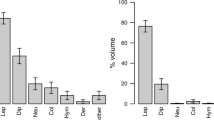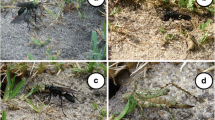Abstract
The trophic ecology of Kuhl’s pipistrellePipistrellus kuhlii (Kuhl, 1817) was investigated monthly from May to October 1999. Nine insect and two arachnid orders were identified in faeces and classified in 24 different categories. The most frequently occurring prey categories were Culicidae, Lepidoptera, Chironomidae/Ceratopogonidae, Hymenoptera, unidentified Brachycera, Tipulidae and unidentified Coleoptera in decreasing order. Other categories exhibited seasonal importance, such as the coleopteranRhizotrogus sp. Prey availability was evaluated monthly using Malaise traps in known feeding areas. Bats preyed selectively through a temporarily changing pattern. Some taxa constituted an important part of the diet and were positively selected either monthly or in most of the months. Many of them were the largest prey featuring in the diet and changes of their relative profitability across time would determine their selection index. The small size of some prey categories as well asP.kuhlii’s morphofunctional constraints relative to flight and echolocation could explain their underexploitation or rejection. Our results suggest thatP. kuhlii could be regarded as a ‘selective opportunist’ species.
Similar content being viewed by others
References
Aihartza J. R. 2001. Quirópteros de Araba, Bizkaia, y Gipuzkoa: Distribución, ecología y conservación. PhD thesis, University of the Basque Country, Bilbao, Basque Country: 1–336.
Aihartza J. R. and Garin I. 2002. Distribución de los murciélagos de los génerosPipistrellus, Hypsugo y Eptesicus (Chiroptera, Mammalia) en el País Vasco occidental. Munibe 53: 229–244.
Alcalde J. T. and Escala M. C. 1999. Distribución de los Quirópteros en Navarra, España. Boletin de la Real Sociedad Española de Historia Natural 95: 157–171.
Altringham J. D. 1996. Bats. Biology and behaviour. Oxford University Press, Oxford: 1–262.
Anthony E. L. P. and Kunz T. H. 1977. Feeding strategies of the little brown bat,Myotis lucifugus, in Southern New Hampshire. Ecology 58: 775–786.
Arlettaz R. 1996. Feeding behaviour and foraging strategy of free-living mouse-eared bats,Myotis myotis andMyotis blythii. Animal Behaviour 51: 1–11.
Arlettaz R., Godat S. and Meyer H. 2000. Competition for food by expanding pipistrelle bat populations (Pipistrellus pipistrellus) might contribute to the decline of lesser horseshoe bats (Rhinolophus hipposideros). Biological Conservation 93: 55–60.
Arlettaz R., Lugon A., Sierro A. and Desfayes M. 1997. Les chauves-souris du Valais (Suisse): statut, zoogéographie et écologie. Le Rhinolophe 12: 1–42.
Barak Y. and Yom-Tov Y. 1989. The advantage of group hunting in Kuhl’s batPipistrellus kuhli (Microchiroptera). Journal of Zoology, London 219: 670–675.
Barlow K. E. 1997. The diets of two phonic types of the batPipistrellus pipistrellus in Britain. Journal of Zoology, London 243: 597–609.
Barlow K. E. and Jones G. 1999. Roosts, echolocation calls and wing morphology of two phonic types ofPipistrellus pipistrellus. Zeitschrift für Säugetierkunde 64: 257–268.
Barrientos J. A. 1988. Bases para un curso práctico de entomología. Asocación Española de Entomología, Barcelona: 3–754.
Beck A. 1995. Fecal analyses of European bat species. Myotis 32–33: 109–119.
Beck A., Gloor S., Zahner M., Bontadina F., Hotz T., Lutz M. and Mülethaler E. 1995. Zur Ernährungsbiologie der grossen HufeisennaseRhinolophus ferrumequinum in einem Alpental der Schweiz. [In: Zur Situation der Hufeisennasen in Europa. Arbeitskreis Fledermäuse Sachsen-Anhalt, ed]. Nebra, Deutschland: 15–18.
Bernedo E. 1996. [Spatial use and phenology of a colony ofPipistrellus kuhlii (Mammalia: Chiroptera) at the Leioa Campus (U.P.V.-E.H.U.)]. MSc thesis, University of the Basque Country, Leioa: 1–47. [In Basque]
Best T. L., Milam B. A., Haas T. D., Cvilikas W. S. and Saidak L. R. 1997. Variation in diet of the gray bat (Myotis grisescens). Journal of Mammalogy 78: 569–583.
Chatterjee M. 1989. Light trap catches and changes in biomass ofNezara viridula L. Geobios (Jodhpur) 16: 258–261.
Chinery M. 1977. Guia de campo de los insectos de España y de Europa. Omega, Barcelona: 5–402.
Feldman R., Whitaker J. O. and Yom-Tov Y. 2000. Dietary composition and habitat use in a desert insectivorous bat community in Israel. Acta Chiropterologica 2: 15–22.
Gaisler J. 1994. The batsPipistrellus kuhli andHypsugo savii on the island of Rab (Croatia). Folia Zoologica 43: 279–280.
González-Álvarez F. and Rodríguez-Muñoz R. 1995. Distribution of bats in Asturias (Northern Spain). Myotis 32-33: 163–181.
Haffner M. and Stutz H. P. 1985/1986. Abundance ofPipistrellus pipistrellus andPipistrellus kuhlii foraging at street-lamps. Myotis 23–24: 167–172.
Hoare L. R. 1991. The diet ofPipistrellus pipistrellus during the pre-hibernal period. Journal of Zoology, London 225: 665–670.
Jones G. 1990. Prey selection by the greater horseshoe bat (Rhinolophus ferrumequinum): optimal foraging by echolocation? Journal of Animal Ecology 59: 587–602.
Jones G. and Barrat E. M. 1999. Vespertilio pipistrellus, Schreber, 1774, V. pygmaeus, Leach, 1825, (currentlyPipistrellus pipistrellus andP. pygmaeus; Mammalia, Chiroptera): proposed designation of neotypes, case 3075. Bulletin of Zoological Nomenclature 56: 182–186.
Jones G. and van Parijs S. M. 1993. Bimodal echolocation in pipistrelle bats: are cryptic species present? Proceedings Royal Society of London. Biological sciences 251: 119–125.
Kalko E. K. 1995. Insect pursuit, prey capture and echolocation in pipistrelle bats (Microchiroptera). Animal Behaviour 50: 861–880.
Kalko E. K. V. and Schnitzler H. U. 1993. Plasticity in echolocation signals of European pipistrelle bats in search flight: implications for habitat use and prey detection. Behavioral Ecology and Sociobiology 33: 415–428.
Lacki M. J., Burford L. S. and Whitaker J. O. Jr 1995. Food habits of gray bats in Kentucky. Journal of Mammalogy 76: 1256–1259.
MacArthur R. H. and Pianka E. R. 1966. On optimal use of a patchy environment. The American Naturalist 100: 603–609.
Manly B., Mcdonald L. L. and Thomas D. 1993. Resource selection by animals. Statistical design and analysis for field studies. Chapman & Hall, London: 1–177.
McAlpine J. F., Peterson B. V., Shewell G. E., Teskey H. J., Vockeroth J. R. and Wood D. M. 1981. Manual of Nearctic Diptera. Research Branch of Agriculture, Ottawa: 1–674.
McAney C., Shiel C., Sullivan C. and Fairley J. 1991. The analysis of bat droppings. Mammal Society, London: 1–48.
Norberg U. M. and Rayner J. M. V. 1987. Ecological morphology and flight in bats (Mammalia; Chiroptera): wing adaptations, flight performance, foraging strategy and echolocation. Philosophical Transactions of the Royal Society of London 316: 335–427.
Rakhmatulina I. K. 1983. [Ecology ofVespertilio kuhlii Kuhl, 1819 in Azerbaijan]. Bulletin of Moscow Society of Naturalists. Biological series 88: 33–42. [In Russian with English summary]
Russo D. 2001. Habitat use by foraging bats (Mammalia: Chiroptera) in southern Italy determined by broad-band acoustic surveys and radio-tracking. University of Bristol, Bristol, UK: 1–214.
Rydell J. 1992. The diet of the parti-coloured batVespertilio murinus in Sweden. Ecography 15: 195–198.
Rydell J., Entwistle A. and Racey P. A. 1996. Timing of foraging flights of three species of bats in relation to insect activity and predation risk. Oikos 76: 243–252.
Sample B. E. and Whitmore R. C. 1993. Food habits of the endangered Virginia big-eared bat in West Virginia. Journal of Mammalogy 74: 428–435.
Schnitzler H.-U., Kalko E., Miller L. and Surlykke A. 1987. The echolocation and hunting behavior of the bat,Pipistrellus kuhli. Journal of Comparative Physiology A 161: 267–274.
Schober W. and Grimmberger E. 1989. Bats of Britain and Europe. The Hamlyn Publising Group, London: 5–224.
Stencel J. E. 1961. The distribution and bionomics of Kuhl’s bat,Pipistrellus kuhli kuhli (Natterer in Kuhl, 1819), in Lebanon (Chiroptera: Vespertilionidae). MSc thesis, American University of Beirut, Beirut, Lebanon: 1–29.
Stephens D. W. and Krebs J. R. 1986. Foraging theory. Princeton University Press, New Jersey: 1–247.
Sullivan C. M., Shiel C. B., Mcaney C. M. and Fairley J. S. 1993. Analysis of the diets of Leisler’sNyctalus leisleri, Daubenton’sMyotis daubentoni and pipistrellePipistrellus pipistrellus bats in Ireland. Journal of Zoology, London 231: 656–663.
Swift S. M. and Racey P. A. 1983. Resource partitioning in two species of vespertilionid bats (Chiroptera) occupying the same roost. Journal of Zoology, London 200: 249–259.
Swift S. M., Racey P. A. and Avery M. I. 1985. Feeding ecology ofPipistrellus pipistrellus (Chiroptera: Vespertilionidae) during pregnancy and lactation. II. Diet. Journal of Animal Ecology 54: 217–225.
Vaughan N. 1997. The diets of British bats (Chiroptera). Mammal Review 27: 77–94.
Vernier E. 1989. Ecological observations on the evening flights ofPipistrellus kuhlii in the town of Padova (Italy). [In: European bat research 1987. V. Hanak, I. Horacek and J. Gaisler, eds]. Charles University Press, Praha: 537–541.
Vernier E. 1995. Seasonal movements ofPipistrellus kuhli: 18 years of observations on a single colony in Padova (N.E. Italy). Myotis 32-33: 209–214.
Vernier E. and Bogdanowicz W. 1999.Pipistrellus kuhlii. [In: The atlas of European mammals. A. J. Mitchell-Jones, G. Amori, W. Bogdanowicz, B. Kryštufek, P. J. H. Reijnders, F. Spitzenberger, M. Stubbe, J. B. M. Thissen, V. Vohralík and J. Zima, eds]. Poyser Natural History, London: 120–121.
Whitaker J. O. Jr, Shalmon B. and Kunz T. H. 1994. Food and feeding habits of insectivorous bats from Israel. Zeitschrift für Säugetierkunde 59: 74–81.
Author information
Authors and Affiliations
Corresponding author
Additional information
Associate Editor was Leszek Rychlik.
Rights and permissions
About this article
Cite this article
Goiti, U., Vecin, P., Garin, I. et al. Diet and prey selection in Kuhl’s pipistrellePipistrellus kuhlii (Chiroptera: Vespertilionidae) in south-western Europe. Acta Theriol 48, 457–468 (2003). https://doi.org/10.1007/BF03192492
Received:
Accepted:
Issue Date:
DOI: https://doi.org/10.1007/BF03192492




